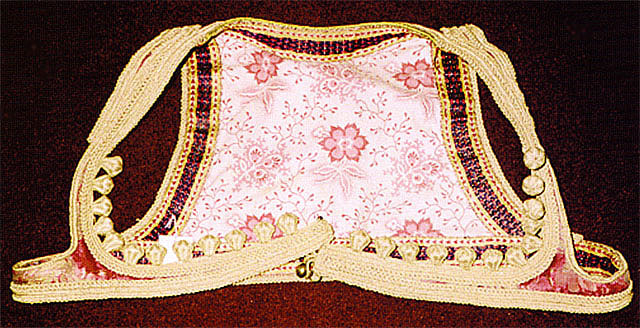Frimla
| This article may require cleanup. The specific problem is: information pasted from external site. Relevant discussion may be found on the talk page. Please help improve this article if you can. (April 2016) |
The Frimla is a combination of a sort of vest and a forerunner of the bra.

I have so far been unable to find out when the Maghribi / Andalusian frimla developed. Since it would not have been visible when out of doors, foreign travellers might not have seen it to comment on it. It was part of visible indoor wear by the mid-16th century, as it is clearly visible in the illustration on the left of an interior costume.
In order to make one, we have to look at those that have survived. The only surviving examples I've seen date from the 19th and 20th centuries.The back looks like that of a short vest coming only a few inches below the armpit with very narrow shoulders. By careful fitting, the frimla gives some support to the sides of the breast. Then it goes under the breasts in front. It certainly doesn't hold them up much if they're large, as can be ascertained from some "period" art, which shows women's "soft tissue" depending over the front band
Reconstructing a Frimla
A frimla would be composed of several layers of fabric: (1) a "nice" outer layer, (2) a practical and durable inner lining, and (3) one layer or several layers of stiffening sandwiched between the first two.
The outer layer of a frimla "in period" would be made of a plain, colored, nice-quality fabric, based on the women's costume as represented in art from the 16th century and earlier, not the velvet or damask of the modern examples, as most garments appear to be made of solid colored fabric, not printed or pattern-woven. Silk was available to the wealthy, otherwise it could be cotton or linen. The lining fabric would be linen or cotton.
I would think wool would not have been used for this interior garment. It appears to me that wool was generally used for outer wear, such as a top layer tunic (like a dalmatica or stola or djellaba worn over the sheer chemise and the outer tunic of silk, cotton or linen) or a cloak/cape/mantle (like a burnous).
In addition, it would not be elaborately ornamented as these 19th and 20th century examples are. Rather, it would not be ornamented at all except for the bands, visible on the outer layer and on the lining layer, going around the bottom edge, armholes, and front opening which are structural as well as decorative.
I suspect the fastening "in period" would be the same as in the 19th and 20th century examples, that is button-and-loop, with one or two buttons, but without all the yellow baubles on the modern examples.
The possible insufficiency of support means that as a female re-creationist, you will likely need to wear a light comfortable support undergarment along with your chemise and frimla. If the frimla gives sufficient support or if none is really needed, then you may be comfortable without additional support. You may also want to wear a tank or halter top under a sheer chemise, which you won't need under an opaque chemise.
